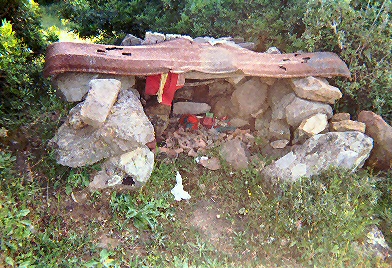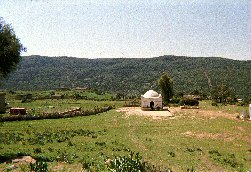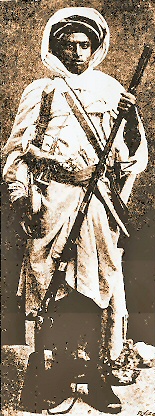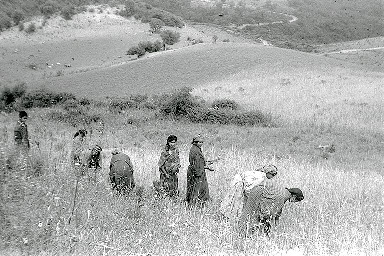Appendix table: Systematic comparison Khumir and Nkoya
Shrines, cults and society in North and Central Africa




Wim van Binsbergen's webpage on Khumiriyya (N.W. Tunisia), late 18th - mid-20th century
Appendix table: Systematic comparison Khumir and Nkoya
Shrines, cults and society in North and Central Africa |
|
|
 |
Wim van Binsbergen's webpage on Khumiriyya (N.W. Tunisia), late 18th - mid-20th century |
return to main text of 1976 paper | return to the index page of Historic Berber culture
(c) 2006 Wim van Binsbergen
Legend:
K = Kroumirs N = Nkoya +
= yes - = no n.a.
= not applicable
( ) difficult to classify; estimate *
major diference between Kroumirs and Nkoya
| VARIABLE |
Khumiriyya |
Nkoya |
Remarks |
||
| 1.
Macro structure and history |
|||||
| 1.1.
Local society belongs to a general linguistic, cultural
and social-structural complex extending over whole
subcontinent |
+ |
(+) |
K:
Maghreb; N: Central Bantu, but more distinct vis-à-is
neighbours , than K |
||
| 1.2.
Participants consider their religion a local variant of a
general religion shared with neighbours |
+ |
(+) |
K:
Islam; N: recognise identity in neighbours’
veneration of High God , ancestors etc . |
||
| 1.3.
prior to European colonisation, local pol. system in
periphery of sphere of influence of remote state |
+ |
+ |
K:
Bey of Tunis etc.; N: Lozi |
||
| 1.4.
Year of European colonisation |
1881 |
1900 |
|||
| 1.5.
The rigid monopoly of central power was inherited
by the independent state without major changes |
+ |
+ |
|||
| 2.
Local social structure |
|||||
| *2.1,
Density of population (inh/km2 ) |
60 |
7 |
|||
| 2.2,
Effective local communities (valleys) are imposed by
ecological/ geomorphologic features |
+ |
+ |
|||
| *2.3.
High social-organisational density of the community |
+ |
- |
K:
highly segmented on many well-defined levels; N:
villages only |
||
| *2.4.
Local communities have a stable membership and are highly
endogamous |
+ |
- |
|||
| *2.5.
Marriage tends to be stable and (for women) once in life |
+ |
- |
|||
| *2
.6. Women become effectively incorporated in the group
into which they marry |
+ |
- |
|||
| 2.7.
Whatever the explicit participants ' ideology, the
underlying kinship structure is bilateral |
+ |
+ |
K:
cf. Van Binsbergen 1970a, 1970b; N: 1976b" |
||
| 2.8.
Subsistence economy, predominantly horticulture" |
+ |
+ |
|||
| 2.9.
No stratification |
(+) |
(+) |
"K:
rural classes beginning to emerge; N: headmanship,
slavery was individual, achieved
status, did not precipitate ascribed and endogamous
classes |
||
| 2.10,
Multiplex, inclusive relationships dominant |
+ |
+ |
|||
| *2.11.
Outside central power, local leadership is diffuse and
shifting |
+ |
- |
|||
| *2.12.
Women lack economic opportunities of their own |
+ |
- |
|||
| 3.
Community shrines |
K |
N
village |
N
valley |
in
K/N comparison, N. village shrines prevail since they
feature much more in ritual than valley shrines |
|
| (*)3.1.
Material form of shrines |
see
remarks |
see
remarks |
see
remarks |
"K:
trees, springs, huts, stone buildings;" N(vil):
wooden poles, shrubs N(val):poles |
|
| (*)3.2.
Shrines are places where an important man or woman was
buried |
(+) |
- |
+ |
K:
also other associations than burial occur |
|
| *3.3.
Regular cemeteries are located around shrines |
+ |
- |
- |
||
| 3.4.
There are keepers for shrine at maximum community level |
+ |
n.a. |
+ |
||
| 3.5.
Shrine cult has ecological connotations mainly |
(-) |
(-) |
+ |
||
| 3,
6. No residential groups without a shrine |
+ |
+ |
+ |
||
| *3.7.
Cult at maximum community level involves all members in
collective ritual |
+ |
n.a. |
- |
||
| *3.8,
Shrines are permanent structures |
+ |
- |
- |
||
| *3,9,
Shrines are linked to other similar shrines through myths
and ritual |
+ |
- |
- |
||
| *3.10,
Shrines are named and associated with individual,
supernatural beings |
+ |
- |
+ |
||
| 3.11.
Shrines are a focus of identity and collective ritual |
+ |
+ |
- |
||
| 3.12.
Shrine cults have a major rallying function for community
members and outside contacts |
+ |
+ |
- |
||
| *3.13.
Compulsory pilgrimages form a device to maintain
interlocal contacts |
+ |
- |
- |
||
| *3.14.
dissociation with shrines legitimates local leadership |
(-) |
+ |
(+) |
K:
used to be so when the lodge/shrine complex was still in
power, while nowadays govt.-appointed chiefs strife in
vain to derive legitimacy from association with shrine;
N(val): officiants must be community leaders, but effect
is reinforcement not legitimation |
|
| *3.15.
The beings associated with the shrines are believed to
take a moral interest in the interaction between
community members |
– |
+ |
(+) |
N(val)
:scarcely documented in Nkoya data but ties in with
general Central?African equation of sin/sorcery/murder,
drought, and infertility |
|
| 3.16.
Affliction attributed to beings associated with community
shrine reflects in-group socialprocess |
+ |
+ |
n.a
. |
||
| *3.17,
Collective shrine ritual is mainly a women's affair |
+ |
- |
- |
||
| *3.18,
Cult staff, as such, pronounce on matters of moral
concern |
(-) |
(+) |
- |
K:
did so in past, before eclipsed by govt. chiefs (1930s);
N(vil): leadership in cult coincides with village
leadership, no special cult staff, but moral issues
abound |
|
| 4.
Ecstatic cults |
K
lodge |
K
outside lodge |
N
non-pro-phetic |
N
pro-phetic |
|
| 4.1,
Percentage of male population inv. |
20% |
20% |
N:
extensive quantitative data now being processed |
||
| *4.2.
Percentage of female population involved |
5% |
80% |
|||
| 4.3.
Membership through initiation |
+ |
+ |
|||
| 4.4.
ritual involves ecstasy |
+ |
+ |
|||
| 4.5.
Individual affliction is the cult’s central theme,
affiliation come in less frequently |
+ |
(-) |
+ |
+ |
K
(outside lodge): Veneration of local saints main theme,
affliction coms in less frquently |
| 4.6.
Leaders have cult shrines |
+ |
(+) |
+ |
+ |
K
(lodge.): the lodge building itself; K (outside lodge):
fekirs concentrating on a particular local saint have
special relation with that saint’s shrine |
| 4.7.
sessions usually involve sets of performers , in a role
structure of leader and adept(s ) |
+ |
(-) |
+ |
+ |
K
(outside lodge): village fekirs usually? perform alone |
| 4.8,
Cult membership is exclusive |
(+) |
(+) |
- |
(+) |
K
(inside and outside lodge): brotherhhoods represented
locally are tolerant of multiple membership, but each
faqir sticks to one major Saint as his object of
veneration; N(prophetic): prophetic cults in their first
phase are exclusive, but e.g. bituma is not anymore |
| 4.9.
Cult ritual is mainly devoted to recruitment (as a means
to treat affliction) |
+ |
(-) |
+ |
+ |
K(outside
lodge): only rarely so –veneration of local saints
predominates |
| 4.10.
Cult sessions have a moderate rallying function of the
local group, not encompassing the total community |
(+) |
+ |
+ |
+ |
K
(lodge) only if lodge-attached fekirs perform outside the
lodge |
| *4.11.
Major cash transactions take place between cult leader
and sponsors |
(-) |
(-) |
+ |
+ |
K(inside
and outside lodge): gifts are only given for divination,
not for treatment |
| *4.12,
During the session the cult leader makes public moral
pronouncements concerning the sponsoring community |
+ |
+ |
(-) |
(-) |
N(prophetic,
non-prophetic) : may allude to in–group strife |
| 4.13.
There is a regional cult centre |
+ |
- |
- |
+ |
|
| 4.14.
There is an interlocal organization |
(+) |
- |
- |
(+) |
K
(lodge), Nkoya (prophetic): weak and declining |
| 4.15.
Strong political aspect |
(-) |
- |
- |
- |
K(lodge):
before colonisation major political functions, since
collapsed |
| 4.16.
Prototypes of the cult have an ancient history locally,
but specific cult forms date from about 1900 or even more
recently |
+ |
(+) |
+ |
+ |
K(outside
lodge): most songs feature local saints whose shrines
locally date from the 19th century |
| 1,17.
Linked to communal shrine cult (?) |
(-) |
+ |
- |
- |
K
(lodge): closely linked in the past |
| 4.18.
Continuity with non-communal cults beyond the linguistic
and ethnic confines of the local society under study |
+ |
(+) |
+ |
+ |
K
(outside lodge): cult forms are identical outside the
Khumiri highlands , but other local saints are
substituted |
return to main text of 1976 paper | return to the index page of Historic Berber culture
The illustrations in the heading of this
webpage:
|
|||
 |